- HOME >
- NEWS >
- Tadashi Kobayashi Gives Commemorative Mikio Mizuta “Global Lecture” Series Keynote in Honor of Josai University Educational Corporation's 50th Anniversary


The Josai University Educational Corporation (Chancellor Noriko Mizuta) commemorated the 50th anniversary of the university's founding with a keynote address on November 21, 2015. Tadashi Kobayashi, Director of the Okada Museum of Art and Chairman of the International UKIYO-E Society, was invited to speak about the “Mizuta Collection and the Appeal of Ukiyo-e” at the Josai University Seiko Hall in the city of Sakado, Saitama Prefecture. Attendees listened enthusiastically to his fascinating lecture. About 500 people filled the hall, from special invitees like Dr. Zoltán Südy―Former Hungarian Ambassador to Japan―to local people, faculty members, students and more.
Dr. Kobayashi’s speech was just one in the Commemorative Mikio Mizuta “Global Lecture” Series being held this year, a part of Josai University’s 50th Anniversary. The university has organized the lecture series in an effort to contribute to the cultivation of global human resources by gathering together people with domestic and international influence, people with outstanding achievements in research, and so on. Many important figures have already contributed to the series. They include the former Prime Minister of Malaysia Mahathir bin Mohamad on May 21, Harvard University Professor Emeritus Ezra F. Vogel on June 13, Nobel Prize in Physics Laureate Makoto Kobayashi on July 9, Studio Ghibli Managing Director and Producer Toshio Suzuki on July 10, and Honorary President of the Japan Business Federation Hiromasa Yonekura on October 1. Dr. Kobayashi, who is the foremost expert in ukiyo-e research, was the sixth speaker to take the stage in the lecture series.
Dr. Kobayashi was born in Tokyo in 1941. He completed his Master’s program in Art History at Tokyo University Graduate School of Humanities. He has held many positions, including Director of the Documents Research Office at the Tokyo National Museum, professor in the Faculty of Letters at Gakushuin University, and Director of the Chiba City Museum of Art. He is known for his chief literary work, “Edo kaiga shiron” (winner of the Suntory Prize for Social Sciences and Humanities). His other well-known published works are “Edo ukiyo-e wo yomu,” “Edo no ukiyo-e,” and “Edo no kaiga.”
Moronobu Hishikawa, the first artist to popularize ukiyo-e, was from the Boso Peninsula of Chiba. Former Minister of Finance and Josai University’s own founder, Mikio Mizuta, was also from the Boso region, and he fell in love with ukiyo-e and began collecting the prints when he was still in school. Many of his early prints were lost during World War II, but he began collecting again once the war was over. He focused mainly on pieces portraying beautiful women or kabuki actors, by artists like Harunobu Suzuki, Utamaro, Sharaku, and Hokusai. After Founder Mizuta passed away, over 200 of his ukiyo-e prints were donated to the Mizuta Museum of Art and became the “Mizuta Collection.” Chancellor Mizuta gave a few remarks before the address. “Dr. Kobayashi was kind enough to evaluate our Mizuta Collection. He has helped us create a wonderful beginning for our museum, and he is an especially important patron to us. I am very pleased to have him here to speak directly to you,” she said.
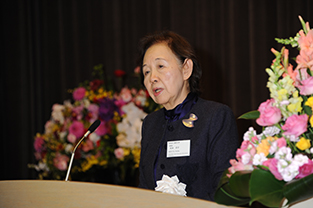
Chancellor Mizuta gives her opening remarks
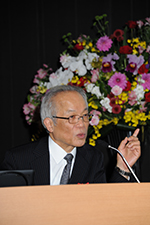
Dr. Kobayashi delivers his keynote
Dr. Kobayashi used Mikio Mizuta’s own words in his speech, saying, “Ukiyo-e is something fun. It reveals the nostalgia of a past that cannot be explained.” Talking about the appeal of ukiyo-e, he went on to explain, “Within it is the expression of the most fundamental of human emotions, and it is because of this that we still feel pleasantly comforted by it today.” “We know this, because even in other countries where the cultural climate is different, they appreciate ukiyo-e. They value highly the ukiyo-e wood prints that display the intimacy and nostalgia hidden in the depths of the heart,” he explained. Additionally, several masterpieces were introduced on a slideshow as attendees learned about the changes to ukiyo-e. Some of the chosen pieces, nine Sharaku prints from the Mizuta Collection, are a highlight of the collection and add much to its worth.
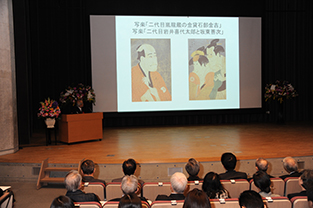
A slideshow introduces several masterpieces
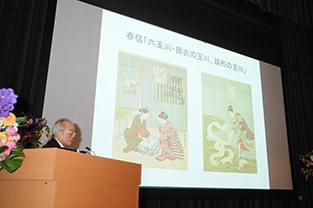
The valuable “Six Tama Rivers” series
During the question and answer session, many students and general attendees asked questions like “Are there any forms of art today that are influenced by ukiyo-e?” and “How many ukiyo-e wood prints can be made at a time with one block of wood?” Dr. Kobayashi was happy to answer them. After the reception following the keynote, Dr. Kobayashi viewed some of the ukiyo-e prints on display at the Mizuta Museum of Art. He also visited the Mikio Mizuta Memorial Hall Exhibition Room, which has been open in the General Gymnasium since July of this year.
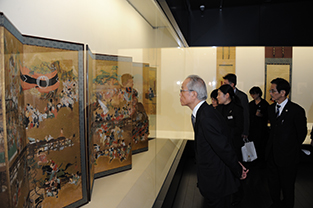
Dr. Kobayashi gazes upon the pieces at the Mizuta Museum of Art
